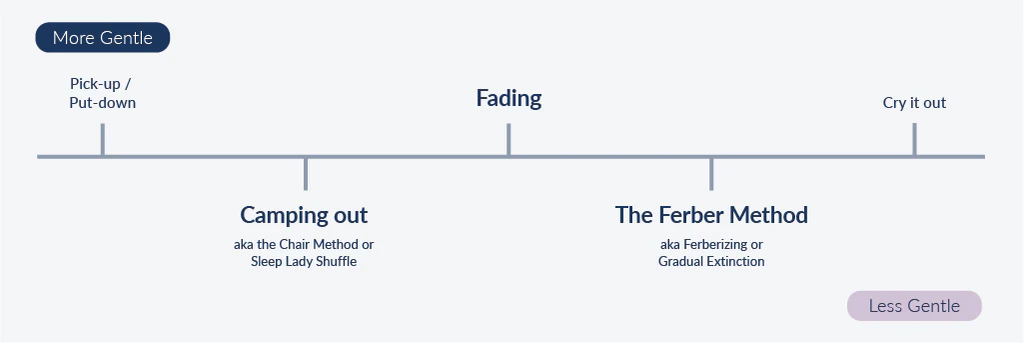
GET STARTED WITH A FREE CUSTOM SCHEDULE AND PLAN OVERVIEW ON OUR MOBILE APP →
TRY BATELLE FOR FREE →

“Gentle” is a great marketing concept in the sleep training industry. It’s a parent-pleasing word that helps reduce the guilt and stigma felt when considering sleep training.
Yet, it’s also vague enough that it’s difficult to define. Even at Batelle, we’ve been guilty of using “gentle” in an effort to explain what we are – and to specifically signal that we are not a “Cry-it-out” program.
Here is our truth: After working with thousands of parents over the years, at Batelle we want to move away from purely defining ourselves as “gentle”, as it can often be misleading. What we deeply care about is following the principles of child psychology that promote engagement and attachment, and continuously improving our method through data and research instead. This is what we have always meant by the word “gentle”.
As we know, it’s easy to claim to be a gentle sleep training program. Every method, sleep consultant, and baby coach will argue that they are “gentle” or that they will find the solution that best fits “your family’s needs”. That often means trying a few things with varying degrees of success before resorting to cry-it-out or one of its variations.
Here is a chart of sleep training methods according to their level of gentleness, found on NestedBean.

The issue is that gentleness is subjective to an individual and doesn’t reconcile different perspectives: Is it gentle from the caregivers’ perspective? Is it gentle from the child’s perspective? Is it gentle in the short term or the long term?
From these different perspectives, one could argue that the sleep training method with the quickest results is also the gentlest, making cry-it-out a strong contender. Alternatively, the method that maintains the most physical proximity between parents and child, or the one with the least amount of tears, could be considered the gentlest. However, it’s important to note that crying, proximity, and results are characteristics that are impacted by much more than the sleep training method in question. Factors such as the quality of support, family application, child’s personality, and other external variables also play a role.
That’s why a chart like the one above only leaves a very confusing spectrum of methods that are categorized as less or more gentle, but without any real quantification of the outcomes from these processes. Therefore, gentleness is often summarized as just “not cry-it-out.”
Let’s address the elephant in the room. If we’re talking about gentle sleep training, it’s because historically sleep training hasn’t felt gentle at all, and parents are left to wonder, even though studies show no adverse side effects (1),(2). From its early forms in the late 1800s with the appearance of cry-it-out, to the popularization of modern sleep training in the 1980s with Ferber, the story has always been that of caregivers reluctantly letting their child cry (3).
An early description of sleep training can be found in Dr. Luther Emmett Holt’s work published in 1894 (4):
“[The infant] should simply be allowed to “cry it out.” This often requires an hour, and in extreme cases, two or three hours. A second struggle will seldom last more than ten or fifteen minutes, and a third will rarely be necessary.”
Because of the necessity to disengage from your child, cry-it-out doesn’t feel gentle for a lot of parents. As humans, we are biologically wired to respond when our child is crying, to physically approach them to assess the situation (5). Not responding to your child or responding at intervals is contrary to our biological urges. Put simply, it’s hard.
Again, we’re not arguing that cry-it-out is fundamentally wrong and we certainly don’t want parents who have done cry-it-out, Ferber or extinction to feel bad about doing so (in fact, 60% of Batelle’s customers have tried cry-it-out in the past). It would be dishonest to suggest that it has never proved successful for some families. But, oftentimes it does fail and it seems increasingly so. The key reason for this is that the parenting zeitgeist appears to have evolved: it doesn’t feel “gentle” to today’s parent who has been taught to attune to their child’s needs when they act in the way a cry-it-out or even Ferber method requires (6).
Due to its historic popularity, cry-it-out and, more recently, Ferber have become benchmarks for sleep training. As a result, the term “gentle” is commonly understood to mean non-cry-it-out. However, this simplistic understanding obscures the question and misses the context: gentle for whom, and over what time frame? If gentle sleep training is not positioned as an alternative to cry-it-out, then what does it entail?
What do we mean by “what works”? We mean what produces the desired outcome. We also mean that parents can embrace and develop principles that align with their modern-day parenting values: responsiveness, good communication, kind boundaries, high engagement, and the desire to attune to their child’s needs. We also mean what works long-term – a framework that stands the test of time, regressions, new daycares, moving house, travels, and life in general.
Lastly, we mean what works in a modern-day context. Parents of the 21st Century have demands and pressures never dreamed of hundreds of years ago. Even in the 50 years since Ferber came to the fore, just think how much has changed. Any sleep training program that “works” in today’s world needs to work for the entire family unit; not just the parents and the child.
This definition of “gentle” doesn’t mean it’s an easy process. It doesn’t mean no tears. And when parents hear “gentle,” this is what they typically expect, which is why we are pushing back against using the word.
When faced with the difficult decision of whether or not to sleep train their child, parents often find themselves searching the internet for the approach that will give them the most confidence that they are doing right by their child. Is the sleep consultant with the most Instagram followers the most credible? Or is it the local consultant who will come to your home and meet your family? Or perhaps the one with the best reviews? The lack of transparency on the process and outcomes of sleep training has created a vacuum filled with empty marketing words, of which “gentle” is king.
When the reality is that parents mainly care about doing something that will benefit their children in the short-term and the long-term while giving the whole family better sleep. For sleep training to be gentle, it needs to work. For it to work, it needs to be based on early childhood science and data.
The understanding of the importance of a strong attachment between a child and their caregivers, as well as the need for clear boundaries has evolved over the last 40 years. Sleep training also needs to evolve to stay relevant for exhausted children and their tired parents.
At Batelle, we don’t want to be measured according to what seems gentle to some or what will just result in less crying. We want to be measured according to how many families find better sleep, not only in the short term but over the first 6 years of a child’s life. We want to be measured according to the child psychology best practices for building a strong relationship with your child. We want to be measured on how well we follow scientific principles, gather learning within our process, and how well we work for families.
Batelle is not for everyone, and being able to attune to your child’s needs does require work on the parents’ part to understand both biological and psychological perspectives. Our way of being gentle with children is not to follow any prescriptive dogma, but instead to base our process on evidence.
There is a lot of work and research to be done in early childhood sleep, and Batelle hopes to lead the way to new understandings to help our little ones sleep better.
